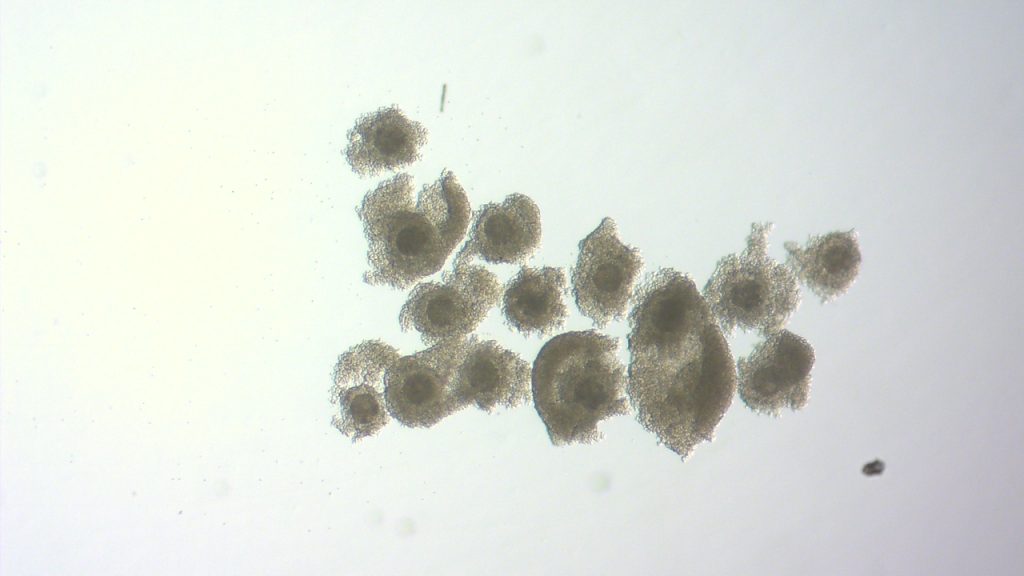IVF is a series of techniques that have been around since the early 1980’s but only recently has the science advanced enough to make the technology commercially viable in cattle. In the late 90’s and early 2000’s there were attempts to use the technology in cattle but there were issues with large calves and abnormalities of the placenta that caused abortions and other difficulties. Recently the technology and science has advanced significantly and solved many of the original issues. The culture media used is of prime importance as it must replace the environment of the cow’s uterus, which is no easy task!
There are several advantages to choosing IVF over conventional flushing:
- Collection of donors every 2 weeks for as long as required.
- Donors can be collected when pregnant up to about 120 days of pregnancy
- Can obtain good embryos from many donors that do not work with conventional flushing.
- Can collect heifers either before or after breeding allowing breeders to accelerate genetic improvement, often in conjunction with genomics.
- Can use rare/expensive semen on multiple donors
- Ability to use sexed semen which does not work with conventional flushing
- Can use Reverse Sorted semen to obtain sexed semen from unsexed frozen semen.
Disadvantages would include:
- Potentially higher cost per embryo depending upon numbers of embryos produced.
- It is not a miracle cure for donors that don’t work conventionally
- If a donor has always had small stimulations in the past she will not be a good IVF donor. ie. Only produces 4 or 5 total ovulations.
IVF is the shortened name for what is actually 4 procedures consisting of:
- OPU – Oocyte Pick UP – We go into a superstimulated donor with an ultrasound guided needle and pull the eggs (oocytes) from the ovaries. The oocytes are then searched under the microscope just like when looking for embryos.
- IVM – In Vitro Maturation – The following steps all occur in the lab hence the name in vitro (latin for “in glass”). Once the oocytes have been located under the microscope they are placed in Maturation Media which is a special culture media intended to mature the oocytes and simulate the process of ovulation where the egg normally undergoes a maturation process that readies the egg for fertilization. This lasts for 24 hours approximately. When we ship the oocytes overnight to the Boviteq lab they are shipped in a special incubator with the oocytes in vials containing the maturation media. When they arrive the next morning they are now ready to be fertilized.
- IVF – In Vitro Fertilization – This step involves processing the semen to remove the extender and dead sperm that did not survive the freezing/thawing process. We want to put 1 million sperm per dish of oocytes. One straw of good semen can potentially be used to fertilize 3-5 dishes of oocytes or several cows could be pooled together. This is especially helpful to maximise the embryo yield from expensive or rare semen. We can also utilise a procedure called Reverse Sorting. In this procedure two straws of unsexed semen is run through the semen sexing machine resulting in the choice to use either male or female sperm (greater than 95% accuracy of sex determination). The sperm is left with the oocytes for 24 hrs and then the oocytes are removed and enter the next stage.
- IVC – In Vitro Culture – In the final step the newly fertilized oocytes are allowed to grow by placing them in specialized culture medium and kept in the incubators until evaluated for stage of growth and embryo quality between 4 and 6 days. At the end of the culture period the embryos are either prepared for shipping back to us for fresh implants into recipient cows or frozen for future implant.
Since we are taking the oocytes out of the uterus and trying to simulate the proper conditions for growth and fertilization the process is very technical and good results are highly dependent upon the skill of the people involved and the lab environment and culture medias used. The oocytes are extremely sensitive to temperature changes, so the collection room where we perform the OPU and the lab all must be at 28-30 C and the surfaces the embryos actually contact must be at 38-39 C. This is a primary reason why all collections must be done at our facility as these conditions would be impossible to implement on farm.

∧ Freshly collected oocytes covered in “nurse cells” called Cumulus Cells.

∧ These are conventionally flushed embryos.

∧ IVF produced embryos that look very similar to conventionally produced embryos
With this process we are able to collect the donors every 2 weeks so planning and scheduling of donors becomes very important.
We are only able to perform OPUs on Wednesdays every week at this time with up to 12 donors per week. We will be maintaining a list of spots for donors and will take bookings for future reservations.
For more information please call Dr. Rob Stables at 587-887-1934 ext 1 or email our Embryo/IVF Lab Manager at office@bowvalleygenetics.com.